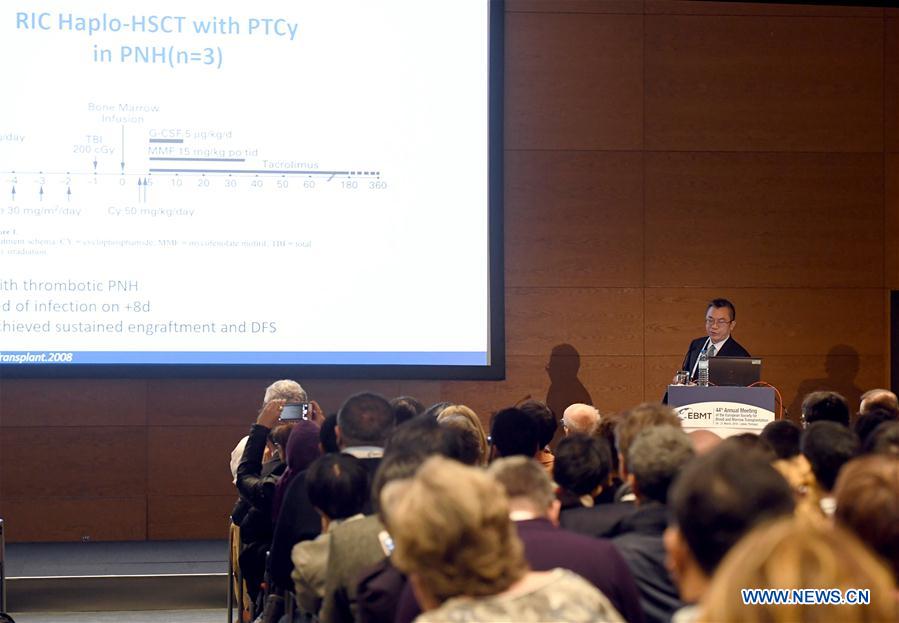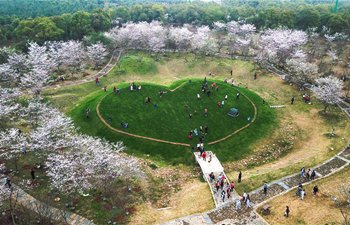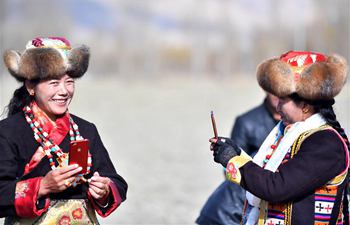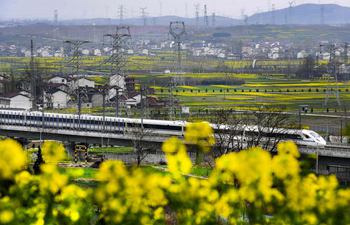
Chinese professor Huang Xiaojun speaks at the meeting of the European Society for Blood and Marrow Transplantation in Lisbon, Portugal, on March 19, 2018. The 44th Annual Meeting of the European Society for Blood and Marrow Transplantation (EBMT) began its second day in Lisbon on Monday with a presentation by Professor Huang Xiaojun, chairman of the Peking University Institute of Hematology. (Xinhua/Zhang Liyun)
LISBON, March 19 (Xinhua) -- The 44th Annual Meeting of the European Society for Blood and Marrow Transplantation (EBMT) began its second day in Lisbon on Monday with a presentation by Professor Xiaojun Huang, chairman of the Peking University Institute of Hematology.
The EBMT annual conference is the most important event concerned with research and education in the field of bone marrow transplantation in Europe. Over 5,000 delegates attend the four-day event to participate in a series of presentations, lectures, discussions and workshops.
Professor Huang was invited to join two French professors Mohamad Mohty, president of the EBMT, and Didier Blaise, an EBMT Scientific Co-Chair in tackling the topic of "Results of haploidentical transplantation." Professor Huang spoke first and focused on results "In non-malignant haematological disease."
Professor Huang is an expert in hematology, a branch of medicine concerned with diseases relating to the blood. His particular area of expertise is hematopoietic stem cell transplantation (HSCT).
Hematopoietic stem cells are generally found in the bone marrow, where they self-renew and mature into all types of blood cells: white blood cells, red blood cells and platelets.
Blood diseases typically occur when immature blood cells become cancerous within the bone marrow. With leukaemia, for example, abnormal white blood cells are formed. White blood cells help the body fight infections and so abnormal cells make the body vulnerable to disease. They also crowd out red blood cells, which supply oxygen to the body, and platelets, which allow the blood to clot.
The most effective way to cure leukaemia is through HSCT. This usually takes the form of a bone marrow transplant (BMT).
The major downside to a BMT is that donors and patients must have matching human leukocyte antigens (HLAs), a series of genomes that help identify the type of cells that belong in a body and its immune system.
If the HLAs don't match, the patient's body will reject the implant and shut down, a fatal process known as graft-versus-host disease (GVHD).
Finding good matches is difficult. A perfect match will only be found in a twin, a high-percentage match in a sibling. This leads to a large imbalance in donor supply and demand, particularly in a country like China, vast in scale and with a one-child policy in a past period.
But Professor Huang and his team pioneered a process where BMTs can be successful when HLAs match by just 50 percent. Such a match is known as haploidentical and typically takes a parent or child as a donor.
The key to haploidentical transplantation is the T-cell, a type of white blood cell believed to be the primary cause of GVHDs. Removing the T-cell prevents the bone marrow from functioning properly, so Professor Huang sought to control it instead.
The results were hugely successful and such advances have practically eradicated the problem of finding donors.
Thanks to Professor Huang's groundbreaking work, Haplo-HSCT came to be known in the sector as the Beijing Protocol. It has been adopted in numerous countries, including Japan, Korea, Israel, Italy and France.
In the United States, a similar procedure, one that also focuses on controlling the T-cell, was developed in Baltimore and has come to be known as the Baltimore Protocol. Conferences such as the EBMT enable specialists to compare notes on the Beijing and Baltimore protocols, as the science behind HSCTs fine-tunes itself.
Thus Professor Huang was at the EBMT to speak about the Beijing Protocol, to provide background on how the process was researched and developed and specifically to talk about how the technique is now being applied to non-malignant diseases, as well as malignant ones like leukaemia.
His presentation focused on the latest progress made in using Haplo-HSCT to treat forms of anaemia, a condition related to a deficiency of red blood cells, inborn errors of metabolism (IMEs), genetic disorders whereby the body cannot properly turn food into energy, and proxysmal nocturnal hemoglobinuria (PNH), a rare blood disease.
"It's very impressive," Professor Blaise said after watching Professor Huang's presentation. "Due to the work and the number of patients being treated in China, and not only in Beijing, the field of transplantation is progressing very rapidly."
"In my own talk I quoted many findings from China, because this is the reality," he added. "What will be very interesting to see in the future is developments in terms of the average age of the patient. The average age in China is much younger and this is very important in terms of long-term survival rates and actions, but cancers are more prevalent in older patients and there are economic implications besides."
Professor Huang has now represented China at the EBMT for five years in a row, a period that Professor Blaise says has seen huge progress in the field.
"These are very exciting times, things are completely changing. We could never have imagined that we'd be talking about these treatments even just a few years ago."















